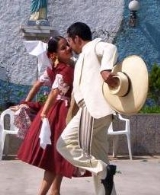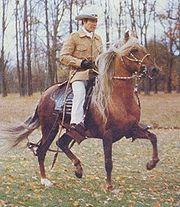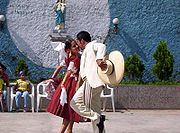
Marinera
Encyclopedia
Marinera is a coastal dance of Peru
, generally called the "National Dance of Peru." Marinera is a graceful and romantic couple's dance that uses handkerchiefs as props. The dance is an elegant and stylized reenactment of a courtship, and it shows a blend of the different cultures of Peru. The dance itself has gained a lot of recognition and is one of the most popular traditional dances of Peru. Ever since the 1960s, during the month of January, in the city of Trujillo
a National Contest of Marinera Nortena is held.
The origin of the Marinera is generally traced back to the Zamacueca
. Nevertheless, there are various other theories about where it comes from. Traditional accompaniment for the dance is provided by cajón
, clarinet
s, guitar
s, drum
s, and bugle
s.
, Moorish, Andean, and Gypsy rhythm influences. Though the marinera dance style had been around for centuries in Peru, it gained the name "marinera" in honor of the Peruvian Navy
or the Marina de Guerra del Peru in 1879 when Peru entered war against Chile. The former name of the dance was "chilena" due to the friendly situations between the two nations , but due to the hostile situation, in a patriotic moment, it was agreed to be renamed.
According to Peruvian historian Romulo Cuneo Vidal, the zamacueca was itself a dance of rest during the times of the Inca empire (And in some Pre-Inca cultures). Thus, coming from such a far natively Peruvian background, the dance is itself simply a derivation of an ancient Peruvian dance. What helps validate this statement are the ancient huacos depicting people resting in the zamacueca positions.
The first Marinera to be written in musical notation was La Concheperla of Abelardo Gamarra and Jose Alvarado, by Rosa Mercedes Ayarza de Morales
in 1894.
 Different schools and dancing styles of the Marinera exist, based on location. There are Marinera dance academies all over Peru, and competitions are frequently held. The most important competition is the National Competition of the Marinera (Concurso Nacional de Marinera) held during the National Festival of the Marinera (Festival Nacional de Marinera), held in Trujillo
Different schools and dancing styles of the Marinera exist, based on location. There are Marinera dance academies all over Peru, and competitions are frequently held. The most important competition is the National Competition of the Marinera (Concurso Nacional de Marinera) held during the National Festival of the Marinera (Festival Nacional de Marinera), held in Trujillo
, every January.
The three main variations are the Marinera Limeña, the Marinera Norteña, and the Marinera Serrana. Sometimes the Marinera is danced with a Chalan
mounted on a Peruvian Paso
(The horse dancing, and the Chalan directing it
Nowadays, the Marinera Limeña seems to be becoming overshadowed by the Marinera Norteña, because of its popular qualities. Nevertheless, the dance still has a small number of fans that dance it during October fests or during the anniversary of Lima
.
 This Marinera had its origins in the Tondero
This Marinera had its origins in the Tondero
of Piura. It acquired characteristics of the Marinera Limeña, and soon enough it became a new variation of the dance. The dance itself tends to be quick-paced and though not as "elegant" as the Limeña, it can also be very stylish. Even though the dance originated in the Northern coasts of the country, it has become quite popular throughout Peru.
It is thanks to that popularity that the Marinera is considered the National Dance of Peru, along with the Peruvian Waltz.
In Marinera Norteña, the man wears shoes, while the woman dances completely barefoot. With constant practice women are even able to dance barefoot on very hot pavement and rough surfaces, as the soles of their feet are well seasoned and toughened up.
There's no "Marinera Dress". Female dancers should wear the typical clothing of the towns where this marinera style is performed. It's mandatory though that women dance barefoot. It is unacceptable for them to wear sandals, canvas shoes, ballet slippers or any kind of footwear to perform this dance.
For the men it is typical to wear "chalan" clothing, with cotton poncho and wide straw hat. In some places they wear a white drill suit. Men wear black, glossy shoes.
Peru
Peru , officially the Republic of Peru , is a country in western South America. It is bordered on the north by Ecuador and Colombia, on the east by Brazil, on the southeast by Bolivia, on the south by Chile, and on the west by the Pacific Ocean....
, generally called the "National Dance of Peru." Marinera is a graceful and romantic couple's dance that uses handkerchiefs as props. The dance is an elegant and stylized reenactment of a courtship, and it shows a blend of the different cultures of Peru. The dance itself has gained a lot of recognition and is one of the most popular traditional dances of Peru. Ever since the 1960s, during the month of January, in the city of Trujillo
Trujillo, Peru
Trujillo, in northwestern Peru, is the capital of the La Libertad Region, and the third largest city in Peru. The urban area has 811,979 inhabitants and is an economic hub in northern Peru...
a National Contest of Marinera Nortena is held.
The origin of the Marinera is generally traced back to the Zamacueca
Zamacueca
The Zamacueca is an ancient colonial dance that originated in the Viceroyalty of Peru, taking its roots from African, Spanish, and Andean rhythms...
. Nevertheless, there are various other theories about where it comes from. Traditional accompaniment for the dance is provided by cajón
Cajón
A cajón is a box-shaped percussion instrument originally from Peru, played by slapping the front face with the hands.-Origins and evolution:...
, clarinet
Clarinet
The clarinet is a musical instrument of woodwind type. The name derives from adding the suffix -et to the Italian word clarino , as the first clarinets had a strident tone similar to that of a trumpet. The instrument has an approximately cylindrical bore, and uses a single reed...
s, guitar
Guitar
The guitar is a plucked string instrument, usually played with fingers or a pick. The guitar consists of a body with a rigid neck to which the strings, generally six in number, are attached. Guitars are traditionally constructed of various woods and strung with animal gut or, more recently, with...
s, drum
Drum
The drum is a member of the percussion group of musical instruments, which is technically classified as the membranophones. Drums consist of at least one membrane, called a drumhead or drum skin, that is stretched over a shell and struck, either directly with the player's hands, or with a...
s, and bugle
Bugle (instrument)
The bugle is one of the simplest brass instruments, having no valves or other pitch-altering devices. All pitch control is done by varying the player's embouchure, since the bugle has no other mechanism for controlling pitch. Consequently, the bugle is limited to notes within the harmonic series...
s.
History
The exact origin of the dance is unknown, but it is an unmistakable blend of , SpanishSpanish people
The Spanish are citizens of the Kingdom of Spain. Within Spain, there are also a number of vigorous nationalisms and regionalisms, reflecting the country's complex history....
, Moorish, Andean, and Gypsy rhythm influences. Though the marinera dance style had been around for centuries in Peru, it gained the name "marinera" in honor of the Peruvian Navy
Peruvian Navy
The Peruvian Navy is the branch of the Peruvian Armed Forces tasked with surveillance, patrol and defense on lakes, rivers and the Pacific Ocean up to 200 nautical miles from the Peruvian littoral...
or the Marina de Guerra del Peru in 1879 when Peru entered war against Chile. The former name of the dance was "chilena" due to the friendly situations between the two nations , but due to the hostile situation, in a patriotic moment, it was agreed to be renamed.
According to Peruvian historian Romulo Cuneo Vidal, the zamacueca was itself a dance of rest during the times of the Inca empire (And in some Pre-Inca cultures). Thus, coming from such a far natively Peruvian background, the dance is itself simply a derivation of an ancient Peruvian dance. What helps validate this statement are the ancient huacos depicting people resting in the zamacueca positions.
The first Marinera to be written in musical notation was La Concheperla of Abelardo Gamarra and Jose Alvarado, by Rosa Mercedes Ayarza de Morales
Rosa Mercedes Ayarza de Morales
Rosa Mercedes Ayarza de Morales was a Peruvian composer....
in 1894.
Peruvian proposal
The claim coming from Peru is that the dance is exclusively Peruvian. According to Peruvian historian Rómulo Cúneo Vidal, the zamacueca was itself a dance of rest during the times of the Inca empire (And in some Pre-Inca cultures). Thus, coming from such a far natively Peruvian background, the dance is itself simply a derivation of an ancient Peruvian dance. A fact that may validate this statement are the ancient huacos depicting people resting in zamacueca positions...African proposal
The African claim is that the Marinera has African roots. African slaves in South America danced the "Zamba culeca," a dance which later was renamed as the "Zamacueca." Thus, since the "Zamacueca" derives from African roots, then all dances that derive from it are also of African descent.Hispanic proposal
Some favor the idea that the ballroom dances of the days of the Viceroyalty (Brought from Europe) are what later evolved into the Latin American dances such as the Marinera. According to its supporters, the European rhythms such as "Fandango" and "Cashuas" led to the creation of the Chilean Sajuriana, the Venezuelan Zambo, the Argentine Cielo Gaucho, the Mexican Tas-be, the Colombian Bambuco, the Ecuadorian Amor Fino, and the Peruvian Toro Mata.Varieties

Trujillo, Peru
Trujillo, in northwestern Peru, is the capital of the La Libertad Region, and the third largest city in Peru. The urban area has 811,979 inhabitants and is an economic hub in northern Peru...
, every January.
The three main variations are the Marinera Limeña, the Marinera Norteña, and the Marinera Serrana. Sometimes the Marinera is danced with a Chalan
Chalan
Chalan or chalán may refer to:* The development of a raga in Hindustani classical music, closely related to the Pakad concept* The rider of a Peruvian Paso horse.* A ferry in México, usually for narrow crossings where there is not a bridge...
mounted on a Peruvian Paso
Peruvian Paso
The Peruvian Paso or Peruvian Horse is a breed of light pleasure saddle horse known for its smooth ride. It is distinguished by a natural, four-beat, lateral gait called the paso llano.-History:...
(The horse dancing, and the Chalan directing it
Marinera Limeña
This Marinera is elegant and a little slow-paced in comparisson to other variations. The dance can be interpreted in low or high tones. The Marinera of contrapunto or "canto de jarana" usually consists of three Marineras, Resbalosa (Slippery), and a succession of "fugas" (Escapes).Nowadays, the Marinera Limeña seems to be becoming overshadowed by the Marinera Norteña, because of its popular qualities. Nevertheless, the dance still has a small number of fans that dance it during October fests or during the anniversary of Lima
Lima
Lima is the capital and the largest city of Peru. It is located in the valleys of the Chillón, Rímac and Lurín rivers, in the central part of the country, on a desert coast overlooking the Pacific Ocean. Together with the seaport of Callao, it forms a contiguous urban area known as the Lima...
.
Marinera Norteña

Tondero
Tondero is a dance and guitar rhythm from the Peruvian north coast .-Geographical origin of tondero and cumananas:The Tondero is a Peruvian dance and rhythm born in the north coast adjacent to the eastern valleys of the Sierra or “yungas” of Piura, Sechura and Lambayeque...
of Piura. It acquired characteristics of the Marinera Limeña, and soon enough it became a new variation of the dance. The dance itself tends to be quick-paced and though not as "elegant" as the Limeña, it can also be very stylish. Even though the dance originated in the Northern coasts of the country, it has become quite popular throughout Peru.
It is thanks to that popularity that the Marinera is considered the National Dance of Peru, along with the Peruvian Waltz.
In Marinera Norteña, the man wears shoes, while the woman dances completely barefoot. With constant practice women are even able to dance barefoot on very hot pavement and rough surfaces, as the soles of their feet are well seasoned and toughened up.
There's no "Marinera Dress". Female dancers should wear the typical clothing of the towns where this marinera style is performed. It's mandatory though that women dance barefoot. It is unacceptable for them to wear sandals, canvas shoes, ballet slippers or any kind of footwear to perform this dance.
For the men it is typical to wear "chalan" clothing, with cotton poncho and wide straw hat. In some places they wear a white drill suit. Men wear black, glossy shoes.
Marinera Serrana
This Marinera is typical from the highland and mountain regions of Peru. It usually has a minor tone and is characterized by a slower movement. This marinera is also repeated twice, and then is followed by a "fuga de huayno". The second part is more sentimental than the first one.External links
- Video "Ferreñafe y Tradición" Marinera composed by Alejandro Segura Dávila
- Video "Ferreñafe y Tradición" Marinera (instrumental version) composed by Alejandro Segura Dávila. Additional information about the province of FerreñafeFerreñafeFerreñafe is a town in Northern Peru, capital of the province Ferreñafe in the region Lambayeque.-External links:* Video Marinera composed by Alejandro Segura Dávila...
in LambayequeLambayequeThe name Lambayeque originates from "Llampayec", an idol that was worshipped in northern Peru. It can refer to the following Peruvian locations:* The city of Lambayeque, Peru* The Lambayeque District* The Lambayeque Province* The Lambayeque Region...
in PerúPeruPeru , officially the Republic of Peru , is a country in western South America. It is bordered on the north by Ecuador and Colombia, on the east by Brazil, on the southeast by Bolivia, on the south by Chile, and on the west by the Pacific Ocean.... - Video "Batuta y Gloria" Marinera (instrumental version) composed by Alejandro Segura Dávila. Additional information about the Peruvian Pisco SourPisco SourA Pisco Sour is a cocktail containing pisco, lemon or lime juice, egg whites, simple syrup, and bitters- Culture :The national origin of the pisco sour is debated. Both Chile and Peru lay claim to the drink. In both countries, the variety of lime used is what North Americans would call Persian lime...
- Video "Mi Cooperativa" Marinera (instrumental version) composed by Alejandro Segura Dávila. Additional information about Perú Cultura Pop
- Marinera limeña (dance)
- Marinera limeña (dance)
- Marinera norteña (dance)
- The Marinera – Peru’s Elegant Dance
- BALLET FOLCLORICO DANZAWASI, DIFUSOR DE LA CULTURA PERUANA EN MÉXICO
- Northern Marinera - The Feet of a Dancer (Short Story)
- What is Marinera?
- Marineras - MIDI Format
- Marinera - The Dance of Peru El Rincón Musical Peruano ¿Qué es la Marinera? Marineras - Formato MIDI Origen de la Marinera 47th annual Concurso Nacional de Marinera

